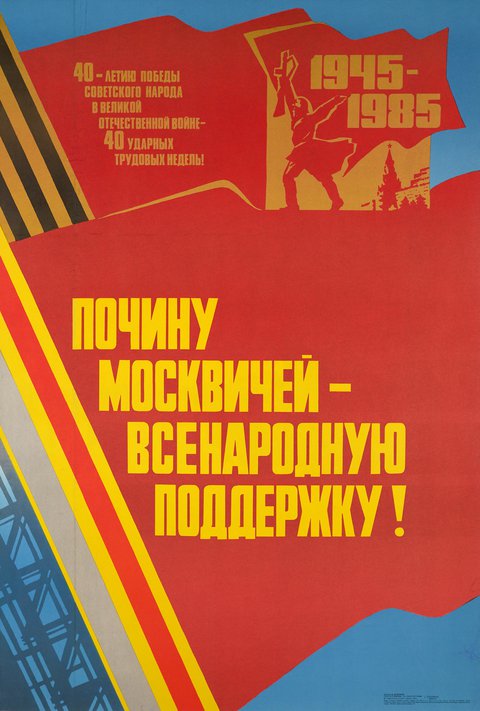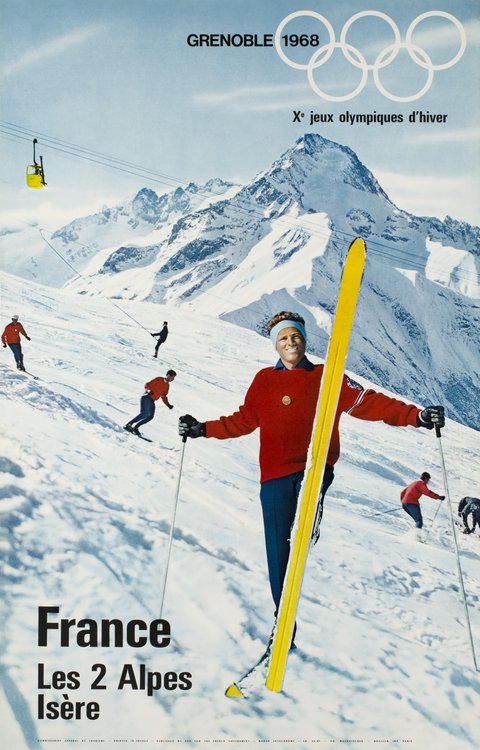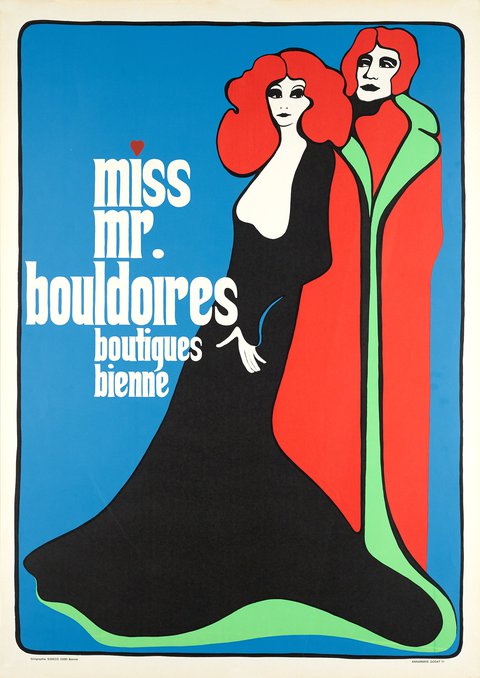A retrospective by Hanne Blitz
Advertising Archaeology
Selection

Switzerland is home to several institutions that hold archaeological collections of regional importance and international renown. Guest writer Hanne Blitz presents some of the posters that advertised their permanent displays and temporary exhibitions.
1940-1949

Sculpturhalle. Antikenmuseum/Sammlung Ludwig, Basel
1941 – ANONYMOUS
This 1941 poster announces the Basel Skulpturhalle’s collection of casts. We see in the foreground the cast of a kore, a sculpture of a young female Greek figure. Other casts of Greek sculpture fill the background. It is worth noting that the collection already included casts of Roman sculpture.
Courtesy Antikenmuseum/Sammlung Ludwig, Basel

Griechische und roemische Kunst. Kunsthalle, Bern
1942 – Kurt WIRTH
Another rare poster from this time is Kurt Wirth’s 1942 'Griechische und Roemische Kunst' (Greek and Roman Art) design for the Kunsthalle Bern. Wirth took his drawing of Nike, the winged Greek goddess of victory, from an ancient Greek red-figure vase painting that was part of the show.
Courtesy Simon Wirth
These are interesting image choices, since both venues could have decided on Roman works of art instead. But Europe was fighting the dictatorial fascist regimes of Hitler in Germany and Mussolini in Italy. In neighbouring neutral Switzerland, anti-imperialist sentiments were running high. Thus, a kore and a deity from ancient Greece, the birthplace of democracy, were the better choice for their exhibitions.
Age

Alt-Peruanische Kunst. Kunsthaus, Zürich
1957 – Werner ZRYD
The body of surviving posters suggests that until around 1960 museums often advertised archaeology by indicating a collection’s age. For example, they described art as “old”, referred to past civilisations and eras, or included a number of years.
Swiss National Library, Prints and Drawings Department: Poster Collection

Kunst der Mexikaner. Kunsthaus Zürich
1959 – Werner ZRYD
Swiss National Library, Prints and Drawings Department: Poster Collection

Kunst und Kultur der Kelten. Museum zu Allerheiligen, Schaffhausen
1957 – ANONYMOUS
< Courtesy Bibliothèque de Genève
Courtesy Stiftung
Ernst Scheidegger-Archiv
Zürich >

5000 Jahre Aegyptische Kunst. Kunsthaus Zürich
1961 – Walter DRAYER, Ernst SCHEIDEGGER
SoldArmin Hofmann

Austellung "Theater Bau von der Antike bis zur Moderne", Helmhaus, Zürich, 1955
1955 – Armin HOFMANN
CHF 1560.–
Two outstanding posters of the time are the work of Armin Hofmann, then director of the Basel School of Design. They incorporate, nearly imperceptibly, a hallmark of the emerging Swiss Style in design: flush left, ragged right body text.
With a few circles, Armin Hofmann summarises 3000 years of amphitheatre and theatre architecture. He designed this brilliant poster for an exhibition on the history of theatre architecture in Zürich in 1955.
Armin Hofmann is considered a leading figure of the Basel School of Design, one of the most progressive Swiss design schools. Teaching at the Basel School of Design from 1946 to 1986, he was pivotal for the Swiss International Style. Hofmann is well-known for his use of black-and-white imagery and his simplification of forms. With this, he accomplished a uniquely expressive, graphic style.
Hofmann used Rome’s founding myth for the 1957 Basel exhibition 'La Suisse à l’époque romaine' (Switzerland in Roman Times) of Roman objects from Swiss museums and private collections. His design is a graceful stylisation of the scene on an ancient limestone relief discovered in Avenches.
Courtesy Matthias Hofmann

La Suisse à l'époque Romaine. Mustermesse Baslerhalle, Basel
1957 – Armin HOFMANN
The Swiss Style
Meanwhile, the Basel and Zürich design schools advocated the Swiss Style’s clarity in layout and typography, and lack of ornamentation. The movement promoted compositional balance in poster design with an asymmetrical layout.

Altrömische Porträtplastik. Kunsthaus Zürich
1953 – Alfred WILLIMANN
Designers applied invisible modular grids as the structural base for aligning different design elements. Alfred Willimann‘s design for the 1953 'Altrömische Porträtplastik' (Ancient Roman Portrait Sculpture) exhibition is a rare archaeological poster that materialises this vision of the Swiss style.
Swiss National Library, Prints and Drawings Department: Poster Collection

3000 Jahre Keramik. Kunstgewerbemuseum Zürich
1965 – Rudolf BIRCHER, George STARK
Four years later, the Swiss sans-serif typefaces Univers and Neue Haas Grotesk appeared. They were immediately successful, with the latter re-named Helvetica in 1960. An excellent example of the Swiss Style is Rudolf Bircher’s discreet 1965 poster '3000 Jahre Keramik' (3000 Years of Ceramics). Its asymmetrical layout, body text, and sans-serif typeface title conformed to the new style’s conventions.
Swiss National Library, Prints and Drawings Department: Poster Collection
The Swiss Style faced much criticism from the early 1970s and gradually lost its prominence in Europe. Occasionally, the style’s influence reappeared well beyond its heyday.

Le don du Nil, art égyptien dans les collections suisses. Musée d'art et d'histoire, Genève
1978 – Jacqueline BÜHLER
< Swiss National Library, Prints and Drawings Department: Poster Collection
Courtesy Musée d’histoire du Valais >

Dix ans d'archéologie en Valais. Musée cantonal d'archéologie, Sion
1997 – ANONYMOUS
It is hard to see whether any other artistic style has affected Swiss archaeological poster design.
Value
In 1953 the Kunsthalle Basel hosted the exhibition 'Schätze Alt-Aegyptischer Kunst' (Treasures of Ancient Egyptian Art). This title was ahead of its time, suggesting a visit to ancient Egypt’s treasures. It thereby emphasised the material value of the archaeological ensemble and not just its age.

Schätze Alt-Aegyptischer Kunst. Kunsthalle, Basel
1953 – ANONYMOUS
SoldCourtesy Kunsthalle Basel
It didn’t take long for a generalised change to occur in museums’ advertising approach. In 1960 the Kunsthalle Basel hosted the exhibition 'Meisterwerke griechischer Kunst' (Masterpieces of Greek Art). Like their show of Egyptian treasures in 1953, the emphasis was on value instead of age. Soon, nearly half the exhibition titles began to reflect the new approach.

Meisterwerke griechischer Kunst. Kunsthalle, Basel
1960 – Peter BIRKHAUSER, Max HIRMER
SoldCourtesy Kaspar Birkhäuser and Eva Birkhäuser-Wertenschlag
This shift coincided with the near total disappearance of drawings in Swiss archaeological posters in favour of photography. Designers adhering to the principles of the Swiss Style preferred photography because of its neutral machine-like precision. Museums and other graphic designers alike were quick to recognise photography’s advantage.

Gold aus Peru. Kunsthaus Zürich
1964 – Walter DIETHELM
< Swiss National Library, Prints and Drawings Department: Poster Collection
Courtesy René GAUCH >

Oro del Peru. Museum Bellerive, Zürich
1977 – René GAUCH
Not only did photography do a better job visualising costly materials and excellence in manual skills, it was also cheaper.

Aus den Schatzkammern Eurasiens. Meisterwerke antiker Kunst. Kunsthaus Zürich
1993 – Heinz & Christa WALDVOGEL
< Swiss National Library, Prints and Drawings Department: Poster Collection >

Kunstschätze aus Alt-Nigeria. Kunsthaus Zürich
1984 – Egon MEICHTRY
Representations of people occurred less often, allowing opportunities for using animal - and other imagery.

Trésors de l'ancien Iran. Musée Rath, Genève
1966 – ANONYMOUS, Jacques SIZA
< Swiss National Library, Prints and Drawings Department: Poster Collection >

Antiker Schmuck aus Griechenland, Byzanz, Syrien und Iran. Galerie Heidi Vollmoeller, Zürich
1963 – ANONYMOUS
The triumph of photography
Museums organising archaeological exhibitions were aware of yet another advantage of photography over illustrations. The unbiased photograph of an archaeological piece reveals what is there and what is not. The photographic truth conveyed time and its ravages more effectively than a subjective illustration ever could. It became a marketing asset for engaging a museum’s target audience that admired the surviving fragments of the past.

Antikenmuseum Basel. Antikenmuseum/Sammlung Ludwig, Basel
1966 – Werner SCHAUB
< Swiss National Library, Prints and Drawings Department: Poster Collection
Courtesy Stiftung Ernst Scheidegger-Archiv, Zürich >

Kunst aus Indien. Kunsthaus, Zürich
1959 – Ernst SCHEIDEGGER
Werner Schaub used this approach in 1966 in his dramatic, elegant composition with a top piece of the Antikenmuseum Basel. Ernst Scheidegger went even further by exploiting photography’s full potential in his poster for the 1959 exhibition 'Kunst aus Indien' (Art from India). Light and shadow nearly breathe life into the moderately erotic representation of the Hindu deities Vishnu and Lakshmi.
Curio
Archaeological exhibitions were rarely organised to celebrate an event. In 1960 'Meisterwerke griechischer Kunst' marked the first 500 years of the University of Basel, Switzerland’s oldest. In 1967 'Altes Sportland Mexiko' celebrated the 1968 Summer Olympics. The poster shows a fully equipped ulama ballgame player on a detail from a Mesoamerican stone Maya ballcourt marker.

Altes Sportland Mexiko. Schweizerisches Turn- und Sportmuseum, Basel
1967 – ANONYMOUS
Swiss National Library, Prints and Drawings Department: Poster Collection
And in 1962 the Kunsthaus Zürich hosted an exhibition of art from ancient Iran. Forty years later the Antikenmuseum Basel/Sammlung Ludwig did the same, using the identical object in their exhibition poster. Both museums emphasised value through the depicted artwork. The Basel museum went a step further. It included age with a gold-coloured title.

Kunstschätze aus Iran. Kunsthaus Zürich
1962 – Walter DRAYER
< Swiss National Library, Prints and Drawings Department: Poster Collection
Courtesy Antikenmuseum/Sammlung Ludwig, Basel >

7000 Jahre persische Kunst. Antikenmuseum/Sammlung Ludwig, Basel
2003 – Markus ZIMMER
Hanne Blitz, MA
Hanne Blitz studied archaeology and art history at Leiden University. He creates content that is at the crossroads of these disciplines. Visit hanneblitz.com > to find out more about him and his artwork. 'Advertising Archaeology' is his first article about vintage posters. He lives near Geneva, Switzerland.
Related selections



Ski sale 2024, Ski en France, en Italie et dans les Alpes



Ski sale 2024 - Affiches de Sports d'hiver



Summer Olympic Games poster



Skiing in France, in Italy and through the Alps



SKIING THROUGH THE ALPS 2023



SKI SALE 2023



Orient-Express



STAR WARS POSTERS



Perpetual calendars



Safety at work in the URSS



Herbert Matter poster



Visit france !



Campari Poster
The Picon posters



Vevey Fête des Vignerons posters



The Conquest of Space



James Bond 007 posters



Ski posters - Winter sports posters



PROPAGANDA - 120 years of Swiss political posters



PROPAGANDA - Soviet Posters



PROPAGANDA - War posters - Peace Posters



Propaganda - 120 years of International propaganda posters - 1898 - 1918 - 1968 - 2018



Winter Olympic Poster



The Swissair Poster Collection



Psychedelic posters in Europe



The object poster Sachplakat



Le Salon de l'auto Genève



Geneva vintage posters



Swiss Poster Award


The Vautier tobacco company by Cassandre



General Dynamics


